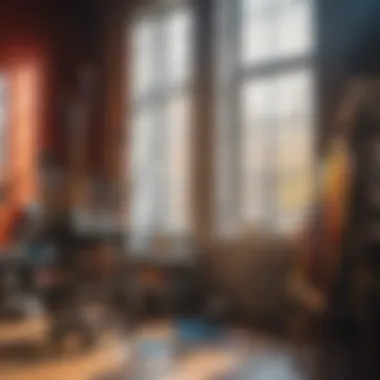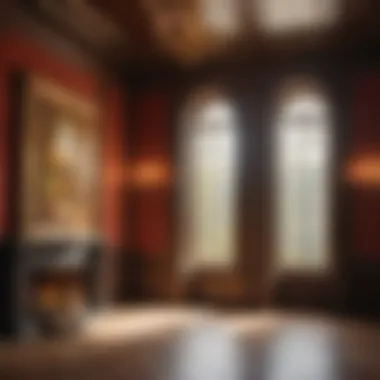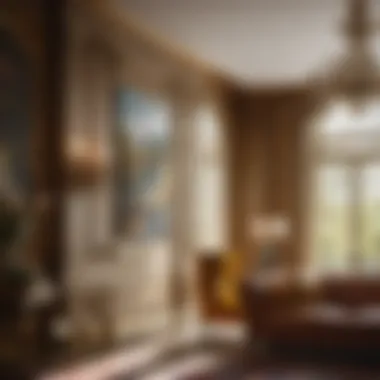Materials:
- High-quality paint in desired colors (exact measurements to be determined based on project size)
- Primer for appropriate surface
- Brushes in various sizes
- Rollers and roller covers
- Painter's tape
- Drop cloths or plastic sheeting to protect floors and furniture
DIY Steps:
-
Preparation: Clear the room of furniture and cover floors with drop cloths. Remove any fixtures or hardware that could be in the way and apply painter's tape to edges and trim where needed.
-
Surface Preparation: Repair any cracks or holes in the walls, sand rough areas, and clean the walls thoroughly to ensure a smooth painting surface.
-
Priming: Apply primer to the walls to enhance paint adhesion and improve the color quality of the final coat.
-
Painting: Use brushes for edges, corners, and detail work, and rollers for larger wall areas. Apply an even coat of paint, allowing proper drying time between coats.
Technical Aspects:
-
Tools: Utilize high-quality brushes and rollers for a professional finish. Consider investing in a paint sprayer for larger projects.
-
Timing: Plan your project timeline carefully, allowing ample time for preparation, priming, painting, and drying between coats.
-
Critical Techniques: Master cutting in along edges, blending brush and roller strokes for a seamless finish, and maintaining consistent pressure for even paint application.
DIY Project Process:


-
Sequential Steps: Follow a systematic approach, starting with preparation, surface priming, and then proceeding with painting. Take breaks as needed to maintain focus and precision.
-
Troubleshooting Tips: Address drips or runs immediately with a dry brush or roller. If colors bleed, apply additional coats or use tape to create clean lines.
Factors Affecting the Cost of Interior House Painting


Painting the interior of a house is a significant project that requires careful consideration of various factors that influence the overall cost. Understanding these factors is crucial for homeowners to make informed decisions. Factors such as the size of the project, the quality of paint used, labor costs, and additional expenses play a pivotal role in determining the average cost of interior house painting.
Size of the Project
The size of the project is a fundamental element that directly impacts the cost of interior house painting. Larger rooms or houses require more paint and labor, leading to higher costs. Factors such as the number of rooms, ceiling height, and the amount of preparation work needed contribute to the overall size of the project. Homeowners should accurately measure the areas to be painted to help paint contractors provide precise cost estimates.
Quality of Paint
When it comes to the quality of paint, two main aspects come into play: the brand of paint and the paint finish.
Brand of Paint
The choice of paint brand is crucial as it can affect both the aesthetics and longevity of the paint job. High-quality paint brands offer better coverage, durability, and color retention, resulting in a more professional finish. While premium brands may cost more upfront, they often require fewer coats and last longer, making them a cost-effective choice in the long run.
Paint Finish
The paint finish refers to the sheen or glossiness of the paint once it dries. Common options include flat, eggshell, satin, semi-gloss, and high-gloss finishes. Each finish has its own set of advantages and disadvantages in terms of durability, ease of cleaning, and aesthetic appeal. Homeowners should select a paint finish based on factors such as the room's function, lighting, and desired final look.
Labor Costs
Labor costs encompass the fees associated with hiring professional painters to complete the job. Experienced painters may charge higher rates due to their expertise and skill level. Regional variances in labor costs also play a role, with urban areas generally having higher rates compared to rural locations. Understanding labor costs is essential for budgeting effectively and ensuring a high-quality paint job.
Additional Expenses
Apart from paint and labor, several additional expenses contribute to the total cost of interior house painting. These include primer costs and supplies and equipment.
Primer Costs
Primer is essential for creating a smooth and durable paint surface. High-quality primers improve paint adhesion and coverage, leading to a more uniform finish. While investing in premium primers may increase upfront costs, they can prevent issues like peeling and discoloration, ultimately saving money in the long term.
Supplies and Equipment
Various supplies and equipment, such as brushes, rollers, drop cloths, and painter's tape, are necessary for a successful paint job. The quality of these materials can impact the overall results, so homeowners should opt for durable and efficient supplies. Investing in quality equipment can enhance painting efficiency and ensure a professional outcome.
Calculating the Average Cost


Calculating the average cost of painting the interior of a house is a crucial step in any painting project. It involves assessing different cost components to estimate the overall expense accurately. By understanding how to calculate the average cost, homeowners can effectively budget for their painting project and avoid any unexpected financial surprises.
Cost per Square Foot
Calculating the cost per square foot is a fundamental aspect of determining the average cost of painting a house's interior. This method involves dividing the total cost of painting by the total square footage of the area being painted. By calculating the cost per square foot, homeowners can easily compare quotes from different painters or contractors and ensure they are getting a fair price for the project.
Hourly Rates for Painters
When considering the hourly rates for painters, homeowners must factor in the experience of the painters and regional variances in pricing. Highly experienced painters may charge higher hourly rates but often deliver superior quality workmanship, which can justify the higher cost. Regional variations in pricing can affect hourly rates, with urban areas typically commanding higher fees compared to rural locations.
Experience of Painters
The experience of painters plays a pivotal role in determining the overall quality and efficiency of the painting project. Experienced painters are well-versed in different painting techniques, possess a keen eye for detail, and can effectively navigate any challenges that may arise during the project. While hiring experienced painters may come at a premium, the peace of mind and the high-quality result they deliver make it a worthwhile investment for homeowners.
Regional Variances
Regional variations in pricing can significantly impact the hourly rates charged by painters. Factors such as the cost of living, demand for painting services, and local economic conditions can contribute to these variances. Homeowners should be mindful of these regional differences when obtaining quotes for their painting project to ensure they are receiving competitive rates without sacrificing quality.
Material Costs
Material costs, including paint, primer, and supplies, are essential components in calculating the average cost of painting a house's interior. The type and quality of materials selected can impact the overall cost of the project. High-quality paint may come at a higher price but can result in better durability and a more professional finish. Primer helps prepare surfaces for painting, enhancing the paint's adhesion and longevity. Additionally, having an ample supply of necessary painting equipment and supplies ensures the project runs smoothly and efficiently.
Paint
The type and brand of paint chosen for the project can significantly influence the cost. Higher-end paints often offer better coverage, durability, and color retention, but typically come at a higher price point. Homeowners should consider their preferences for paint quality and budget constraints when selecting the paint for their interior painting project.
Primer
Primer is a critical component of any painting project as it helps create a smooth and uniform surface for the paint to adhere to. High-quality primers can improve paint adhesion, hide imperfections, and enhance the overall finish of the paint job. Investing in a good primer can contribute to the longevity and quality of the painted surfaces.
Supplies
Having the necessary painting supplies, such as brushes, rollers, drop cloths, and tape, is essential for completing the project efficiently. Quality supplies can make a significant difference in the final outcome of the paint job, ensuring clean lines, even coverage, and professional results. Homeowners should budget for adequate supplies to avoid interruptions or delays during the painting process.
Budgeting and Cost-Saving Tips
Budgeting and cost-saving tips play a crucial role in the overall process of painting the interior of a house. Effective budgeting ensures that the project stays within financial constraints while still achieving desired results. By carefully planning and considering various cost-saving strategies, homeowners can maximize the value of their investment in painting their home.
DIY vs. Hiring Professionals
When contemplating whether to take on the painting project as a do-it-yourself (DIY) endeavor or hire professional painters, several factors come into play. DIY painting can be cost-effective but requires time, effort, and skill. On the other hand, hiring professionals may incur higher costs but ensures a high-quality finish and saves time. Homeowners should assess their capabilities, available time, and desired outcome to make an informed decision that aligns with their preferences and budget.
Negotiating with Painters
Negotiating with painters can be an effective way to secure a favorable deal while maintaining quality standards. Establishing clear communication regarding project details, scope of work, timelines, and pricing upfront can lead to mutually beneficial agreements. Homeowners should conduct research, compare quotes from different painters, and negotiate terms to ensure they receive competitive pricing without compromising on the quality of work.
Timing of the Project
The timing of an interior painting project can impact overall costs and efficiency. Scheduling the project during off-peak seasons or weekdays when painters are less in demand can result in lower rates. Additionally, planning the project well in advance allows for flexibility in scheduling and potential discounts. By considering the timing strategically, homeowners can optimize both cost savings and convenience.
Considering Seasonal Factors
Seasonal factors such as humidity, temperature, and natural lighting can affect the paint application process and drying times. Painting during optimal weather conditions ensures the longevity and quality of the paint job. Homeowners should be mindful of seasonal variations in climate and plan the project accordingly to achieve the best results. By accounting for seasonal factors, homeowners can enhance the overall durability and aesthetics of their freshly painted interiors.
Final Thoughts
In the realm of interior house painting, final thoughts hold substantial weight in the decision-making process, enveloping crucial considerations that can marshall the entire project towards success or potential pitfalls. As homeowners navigate through the labyrinth of choices and variables in the painting endeavor, it is the final thoughts that serve as the compass, guiding towards a satisfactory outcome. Embracing final thoughts involves reflecting upon the entire journey from inception to completion, amalgamating lessons learned, achievements unlocked, and potential areas for improvement. It encapsulates a moment of introspection where the homeowner can bask in the fruits of their labor, celebrating a well-executed project.
When delving into the final thoughts of an interior painting project, it is imperative to contemplate the journey holistically, understanding the implications of each decision made, each brushstroke applied, and each nuance in the color palette chosen. Final thoughts transcend mere reflection; they offer a platform for growth, enabling individuals to harness newfound knowledge and insights for future endeavors. By acknowledging the significance of final thoughts, homeowners can cultivate a deeper appreciation for the intricacies of house painting, unlocking a realm of possibilities for enhancing not just the aesthetics of their living space but also their overall satisfaction and contentment.
In the context of this article, final thoughts serve as the cornerstone of the narrative, knitting together the various facets explored – from analyzing project size and paint quality to labor costs and additional expenses. As readers immerse themselves in the landscape of interior house painting, the final thoughts segment acts as a crescendo, orchestrating a symphony of information that harmonizes into actionable insights and informed decision-making. It prompts individuals to pause, reflect, and ponder upon the wealth of knowledge imparted, propelling them towards a more discerning approach to their painting endeavors.





